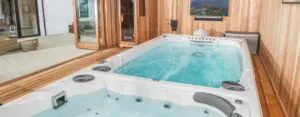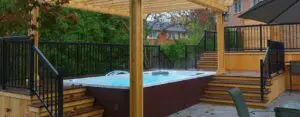October 22, 2025
Category: Sauna & Steam
Most indoor electric saunas come down to three decisions: heater size, power supply, and ventilation. Once those are set, you can estimate running costs and plan where it fits in your routine. You’ll also get siting ideas for small spaces and a quick chooser to confirm whether electric fits your routine.
Tip: If you’re in a town or city, check local smoke‑control rules. Electric models aren’t restricted, so they suit terraces and tight streets.
What is an electric sauna, and how is it different from infrared?
An electric heater warms stones and the surrounding air. You add water to the stones to create steam bursts and the familiar löyly experience. Infrared warms your body directly through panels and runs at lower air temperatures. If you want classic heat with steam and a simple timer, an electric setup is a straightforward choice.
What size electric sauna heater do you need for your room?
Match the electric sauna heater to the room volume. As a simple rule of thumb, smaller rooms suit 3–4.5 kW, medium rooms suit 4.5–6 kW, and larger family cabins may need 6–9 kW. Rooms with large areas of glass or stone need more power, so size up one level. Measure length × width × height, then check the quick guide; size up if you have heat‑storing surfaces.
Quick sizing guide
- 4–6 m³ room volume: consider a 4–6 kW heater
- 6–8 m³ room volume: consider a 6 kW heater
- 8–10 m³ room volume: consider a 6–8 kW heater
Worked example: A 2.0 × 2.0 × 2.1 m room is 8.4 m³. Start around a 6 kW heater.
Example scenario (ensuite): An 8.4 m³ ensuite needed a 6 kW heater once we allowed for a glass door. We ran the cable via the airing cupboard and fitted a local isolator.
If you’re unsure, book a home visit and we’ll confirm the right size for your space and finishes.
What power supply does an electric sauna need in the UK?
Plan a dedicated circuit with RCD protection and a local isolator, installed by a qualified electrician. In England and Wales this falls under Building Regulations Part P. Most 3–6 kW heaters run on single‑phase; bigger units may need three‑phase. Your electrician will specify the breaker, RCD protection, cable route, and local isolator. In bathrooms and outbuildings, moisture zones and protection matter, so involve your electrician early.
Do I need three-phase power at home?
Heaters around 9 kW and above may need three-phase. Always check the manufacturer’s specification and use a qualified electrician.
Mid‑project CTA: Get a room‑by‑room plan. We’ll size the heater, confirm the power route, and leave you with a detailed quote.
How much does an electric sauna cost to run?
You can estimate running costs from your tariff and the heater size. As a simple example at £0.30 per kWh:
- 3 kW heater: about £0.90 per hour while heating
- 4.5 kW heater: about £1.35 per hour while heating
- 6 kW heater: about £1.80 per hour while heating
A typical session has a warm‑up phase, then a lower maintenance phase. For example, a 6 kW heater warming up for 30 minutes uses about 3 kWh (~£0.90). If you then maintain temperature for 60 minutes at about 4 kW on average, that adds £1.20). The whole session comes in around £2.10. Your costs will vary with insulation, cabin size, target temperature, and tariff.
Do electric-heated saunas need ventilation?
Yes. Fresh air makes sessions feel better and helps the heater control temperature. Provide a low‑level supply and a high‑level extract so air moves across the room without blowing on the sensor. Follow your heater and cabin maker’s guidance for vent size and placement, and keep vents clear.
Can I put an electric sauna in a bathroom?
Yes. Use moisture‑tolerant finishes, check clearances, and run a Part P‑compliant circuit with a local isolation switch. Place vents so air moves across the room without blowing on the sensor.
How long does an electric sauna take to heat up?
Most home electric saunas reach bathing temperature in 20–45 minutes, depending on room volume, insulation, starting temperature, and heater kW. Use the timer to preheat, keep the door closed, and improve insulation to reduce warm‑up time.
Can you install an electric sauna indoors or outdoors?
Yes. Indoors and outdoors both work when you match finishes and electrics to the space and leave service access. Indoors, choose moisture‑tolerant finishes, check clearances, and agree a cable route with your electrician that meets the rules. In gardens, use a weather‑resistant cabin on a level base, protect the cable run, and plan lighting for safe evening use.
Which indoor sauna suits your space?
Oasis Sauna (indoor cabin): 3–4 persons, 214 × 160 × 201 cm. Includes sauna stones, three benches, headrests, backrests, and lighting. £7,695 inc VAT.
Radiant Sauna (indoor cabin): 4–5 persons, 208 × 206 × 204 cm. Three benches, with sauna stones and accessory kit included. £7,955–£7,995 inc VAT.
Tylo Reflection Glass Front (Small): Premium glass‑fronted design for modern interiors. 4 persons, 179.6 × 178.9 cm. £22,276.77 inc VAT.
Tylo Reflection Glass Corner Wide (Small): Corner layout maximises floor area in en‑suites or gyms. 4 persons, 175.6 × 177.1 cm. £21,125.33 inc VAT.
Installed by our in‑house team. Finance available, subject to status.
Prices correct as of 12 September 2025; subject to change. See product pages for live pricing.
Where should you site a home sauna for weeknight use?
Place it close to the house or bathroom door, out of the prevailing wind, with a straight approach for delivery. Plan non‑slip, lit paths, and keep steps shallow. If you use the sauna after work, convenience is everything, so reduce obstacles between the door and the cabin.
Why it matters: Smart placement makes weeknight sessions easy, which is when most owners use their sauna.
Quick chooser: when is electric the best option?
- You live in a smoke‑control area and want a compliant heater
- You value timer control, fast warm‑up, and predictable bills
- You want flexible siting in dense streets and terraces
- You prefer simple upkeep without fuel storage
If you like the ritual of logs and live outside smoke‑control zones, compare options in our wood‑fired sauna guide, then return to electric if you want timers and quiet operation. Still deciding between heat sources? See our Electric vs Traditional guide, then choose the setup that matches your home and routine.
What are your next steps to plan an indoor electric sauna?
Ready to plan your indoor sauna? Book a site assessment and our in‑house team will confirm heater sizing, power, and ventilation, then provide a costed plan. You can also review finance options, check sales offers, and ask about servicing through our owners hub.
For outdoor sauna cabins and all‑weather layouts, please see our outdoor saunas.
Want to try heat levels in person? Drop into Sidcup (Ruxley Manor) or Gillingham (Dobbies) and talk layouts with a specialist.


